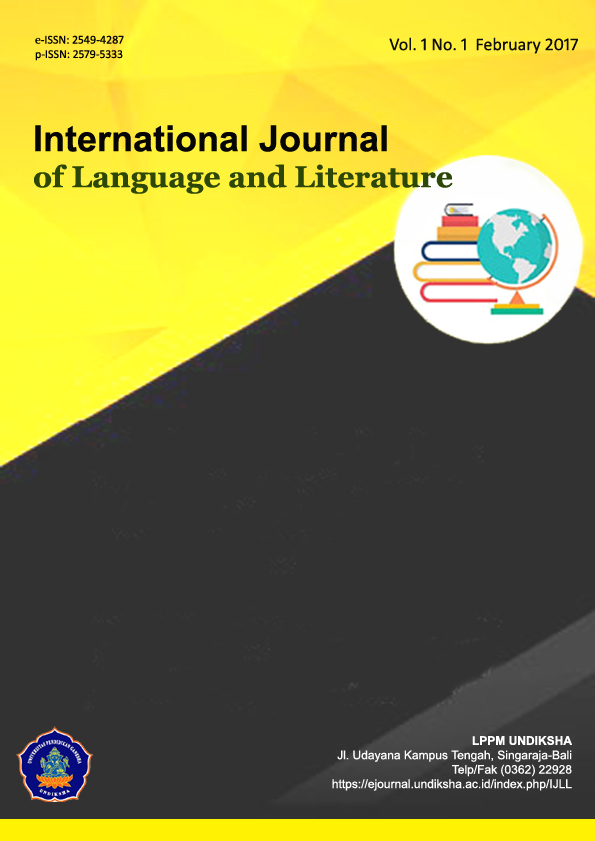AN ANALYSIS OF CLASSROOM STUDENTS’ MISBEHAVIORS IN MECHANICAL ENGINEERING DEPARTMENT CLASS OF GRADE XI IN SMK NEGERI 3 SINGARAJA
DOI:
https://doi.org/10.23887/ijll.v1i1.9622Keywords:
classroom management, students’ misbehaviors, young adolescent learnersAbstract
This descriptive qualitative research was aimed at finding out the kinds of students’ misbehavior in the classroom of Mechanical Engineering Department of grade 11 in SMK Negeri 3 Singaraja, knowing the students’ reasons for doing misbehaviors in the classroom, and also the aim at knowing the teacher’s responses towards the students’ misbehaviors happened in the classroom. The subject of this research was all students in the classroom of Mechanical Engineering Department of grade11 and their English teacher. Observation and interview were the techniques used to collect the data of this research. Descriptive qualitative techniques were then used to analyze the data that was gathered. The result of this research showed that there were ten kinds of students’ misbehavior happened in the classroom of Mechanical Engineering Department grade 11 in SMK Negeri 3 Singaraja. Those misbehaviors were inattention, apathy, needless talk, moving about the room, annoying others, disruption, lying, cheating, aggression and fighting, and also defiance of authority. Six of those misbehaviors happened consistently and four of those misbehaviors happened inconsistently in the classroom. There were found six students’ reasons for doing those ten kinds of misbehavior in the classroom. After that, there were found five teacher’s responses towards misbehaviors done by the students in the classroom of Mechanical Engineering Department of grade 11 in SMK Negeri 3 Singaraja.
References
Ahmed, N. (2013). A study on the reason for student’s misbehavior in class and academic remedial measures to curb student’s misbehavior in class at higher educational institutions. International Journal of Research in Commerce & Management, 4(11), 4-8. Retrieved on February 2, 2016 from https://www.researchgate.net/profile/Nazneen_Ahamed/publication/259463058_A_Study_on_the_reasons_for_student%27s_Misbehaviour_in_class_and_academic_remedial_measures_to_curb_student%27s_misbehaviour_in_class_at_higher_educational_Institutions/links/0046352bd09f300cbe000000.pdf?origin=publication_detail
Al‐Zu'bi, Z. H. (2013). Classroom management problems among teacher students training at Hashemite University. European Journal of Business and Social Sciences, 2(3), 140-149. Retrieved on February 2, 2016 from http://www.ejbss.com/Data/Sites/1/vol2no3june2013/ejbss-1258-13-classroommanagementproblems.pdf
Charles, C. M., &Senter, G. W. (2008). Building classroom discipline (9th ed.). USA: Pearson Education, Inc.
Grant, L. G. (2007). A descriptive qualitative study of what informs and influences smoking behavior in community dwelling persons with severe and persistent mental illness. Retrieved on January 5, 2016 from https://open.library.ubc.ca/media/download/pdf/831/1.0101208/2/1695
Harmer, J. (2003). The practice of English language teaching (3rd ed.). UK: Cambridge.
Hughes, C. (2016). An introduction to qualitative research. United Kingdom: University of Warwick.
Kulinna, P. H. (2008). Teachers’ attributions and strategies for student misbehavior. Journal of Classroom Interaction, 42(2), 21-30. Retrieved on February 10, 2016 from http://files.eric.ed.gov/fulltext/EJ829002.pdf
Lake, A. (2011). The State of the world’s children 2011. New York: UNICEF.
McNeely, C., & Blanchard, J. (2009). The teen years explained: A guide to healthy adolescent development. United States of America: Center for Adolescent Health.
Omoteso, B. A., &Semudara, A. (2011). The relationship between teachers’ effectiveness and management of classroom misbehaviors in secondary schools. Scientific Research, 2(9), 902-908. doi:10.4236/psych.2011.29136
Özben, S. (2010). Teachers’ strategies to cope with student misbehavior. Procedia-Social and Behavioral Sciences, 2(2), 587-594. doi:10.1016/j.sbspro.2010.03.068
Patton, M. Q., & Cochran, M. (2002). A guide to using qualitative research methodology. UK: MedecinsSansFrontieres
Rehman, M. H., &Sadruddin, M. M. (2012). Study on the causes of misbehavior among South-East Asian children. International Journal of Humanities and Social Science, 2(4), 162-175. Retrieved on December 1, 2016 from http://www.ijhssnet.com/journals/Vol_2_No_4_Special_Issue_February_2012/21.pdf
Sandelowski, M. (2000). Focus on research method: Whatever happened to qualitative description? Research in Nursing & Health, 23 (4), 334-340. Retrieved on February 15, 2016 from https://www.researchgate.net/file.PostFileLoader.html?id=54a01901d2fd64151f8b4726&assetKey=AS%3A273659606831110%401442256942838
Salyers, F., & McKee C. (2016). The young Adolescent Learner. Retrieved on Mei 14, 2016 from https://www.learner.org/workshops/middlewriting/images/pdf/W1ReadAdLearn.pdf
Sugiyono. (2011). Metodepenelitiankuantitatifkualitatifdan R & D. Bandung: Alfabeta.
Summer. (2007). Characteristics of the Adolescent Learner. Retrieved on Mei 21, 2016 from http://www.montgomeryschoolsmd.org/uploadedFiles/schools/loiedermanms/homepage/Characteristics%20of%20the%20Adolescent%20Learner.pdf
Yuan, X., &Che, L. (2012). How to deal with student misbehavior in the classroom? Journal of Education and Developmental Psychology, 2(1), 143-150. http://dx.doi.org/10.5539/jedp.v2n1p143
Yoncalik, O. (2010). Students’ misbehavior in physical education lesson: A sample from Turkey. Electronic Journal of Research in Education Psychology, 8(1), 59-86. Retrieved on February 15, 2016 from http://www.investigacion-psicopedagogica.org/revista/articulos/20/english/Art_20_359.pdf
Downloads
Published
How to Cite
Issue
Section
License
IJLL Journal provides immediate open access to its content on the principle that making research freely available to the public to supports a greater global exchange of knowledge.

This work is licensed under a Creative Commons Attribution-ShareAlike 4.0 International License








